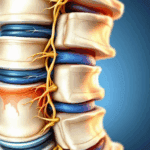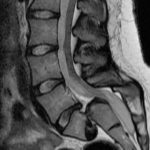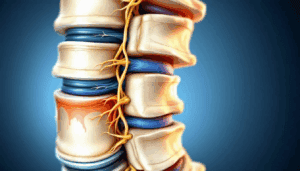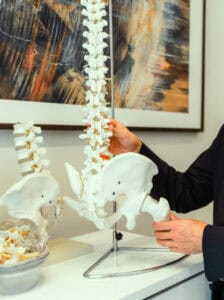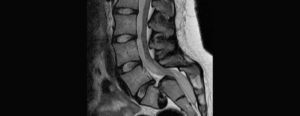
Key Symptoms of Sciatica Pain: How to Recognize and Manage
Wondering if your lower back and leg pain is sciatica? The key symptoms of sciatica pain include sharp pain, tingling, numbness, and muscle weakness. Read on for a detailed look at each symptom and tips for managing your pain.
Key Takeaways
- Sciatica pain arises from irritation or compression of the sciatic nerve, manifesting as radiating pain from the lower back to the leg.
- Key symptoms include radiating pain, tingling, numbness, and muscle weakness affecting mobility, and severe symptoms necessitate immediate medical attention.
- Effective management involves conservative treatments, such as physical therapy and medications, while severe cases may require injections or surgical interventions.
I feel your pain…
As a consultant spinal surgeon who has seen thousands of patients with sciatica and experienced this debilitating pain myself, I understand the agony it brings. The burning pain, the relentless nerve pain, and the chronic pain that disrupts every aspect of life are all too familiar to me. Whether it’s a mild ache or severe pain that makes even the smallest movement feel like a monumental task, sciatica leaves an indelible mark on one’s daily existence.
But there is hope. With the right knowledge and strategies, it’s possible to manage pain effectively and reclaim your life. From understanding the underlying causes to recognizing when the pain persists and requires medical intervention, this guide aims to equip you with the tools needed to navigate and alleviate sciatica pain.
Discover how to turn your agony into action.
Understanding Sciatica Pain
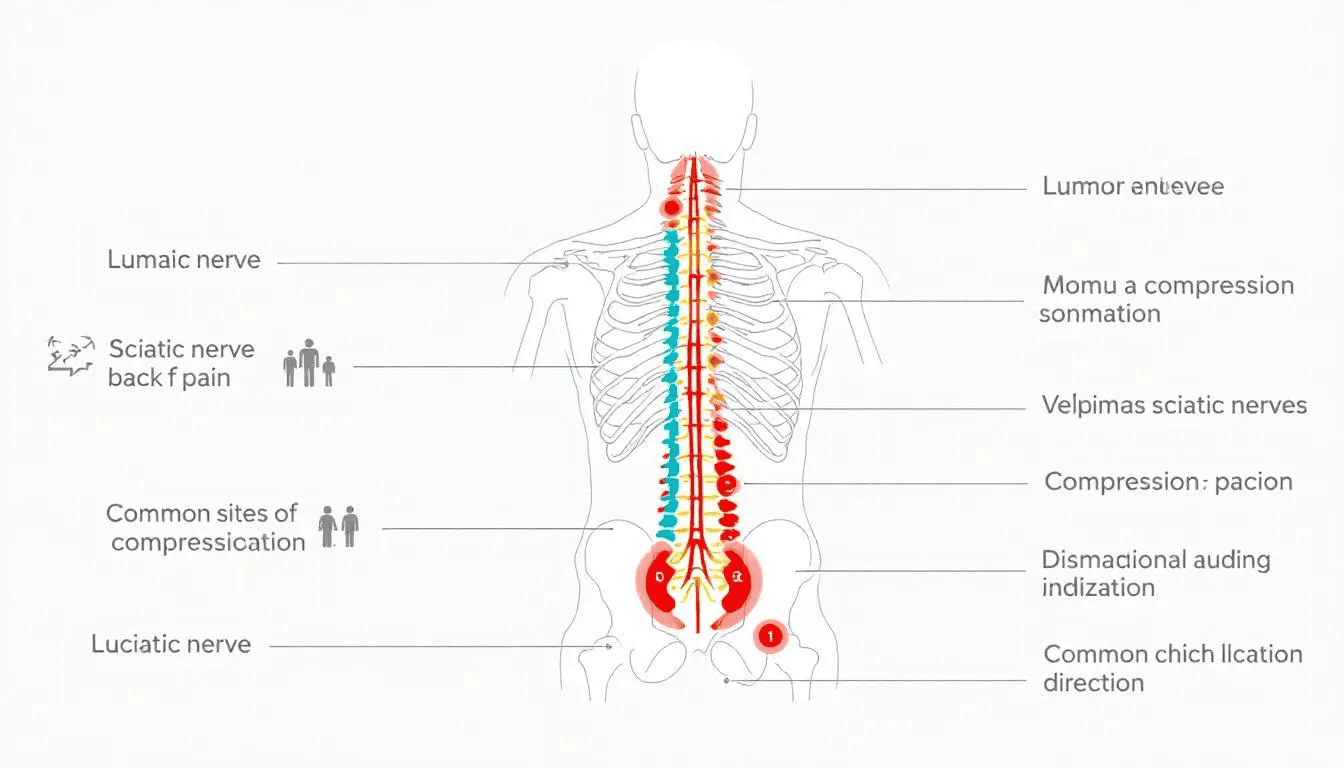
Sciatica pain refers to discomfort that originates in the lower back or buttock and radiates down the leg, often following the path of the sciatic nerve. This large nerve runs from the lower spine down to the feet, making it one of the most extensive nerves in your body. Sciatic pain occurs when this nerve is irritated or compressed, leading to pain that can range from a mild ache to severe and debilitating discomfort.
The sciatic nerve is essential for transmitting pain signals along its pathway. When it is compressed or irritated, the resulting pain is classified as nerve pain, which can significantly affect one’s quality of life. Sciatica is a symptom indicative of an underlying issue, such as herniated discs or spinal stenosis, rather than a medical condition in itself. Understanding this is crucial for both treating and preventing sciatica effectively, especially when considering the role of the nerve root.
While many individuals recover from sciatica within a few months, others may experience ongoing symptoms for a longer period. Chronic sciatica is defined as pain persisting for more than eight weeks or recurring intermittently over months or years. The pain characteristics are diverse, often including burning pain, shooting pain, or even a mild ache. Early recognition and appropriate treatment can significantly improve the management and alleviation of sciatica pain. If you’re wondering how long does sciatica last, it’s important to consult a healthcare professional for personalized advice.
Recognizing Sciatica Symptoms
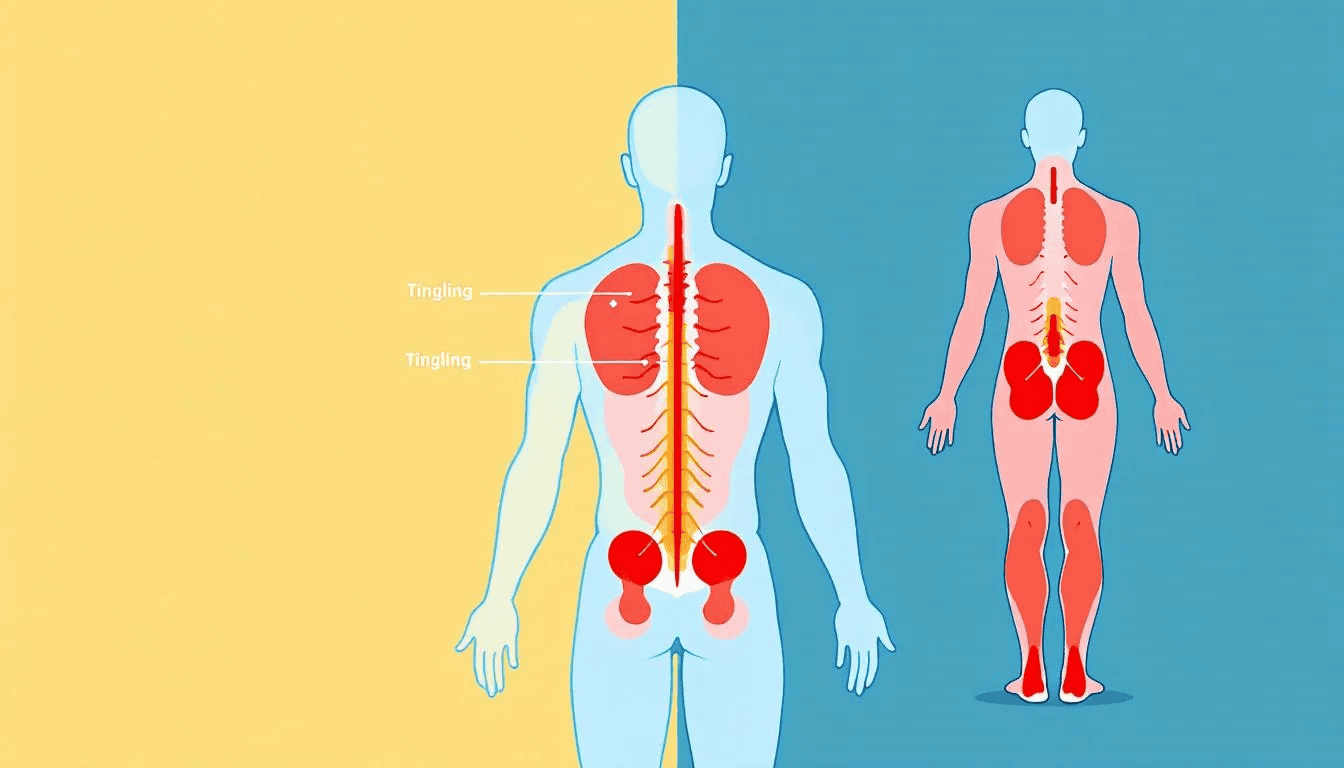
The primary symptom of sciatica is pain along the sciatic nerve path, typically radiating from the lower back through the buttock and down one leg. This pain can manifest in various forms, from intense shooting or searing pain to a dull ache. It often includes tingling or numbness along the affected nerve pathway, impacting daily activities and overall quality of life. Sciatica typically affects only one side of the body.
Sciatica pain can be exacerbated by actions like coughing, sneezing, or lifting the legs while lying down. Additionally, movements such as bending or sitting for long periods often increase the pain. Associated symptoms may include leg pain, numbness and weakness, which can affect movement and stability. Understanding how sciatica occur is the first step in seeking appropriate treatment.
Delving deeper into specific symptoms helps in better recognition and addressing them.
Radiating Pain
Radiating pain is one of the hallmark symptoms of sciatica. This pain typically starts in the lower back and travels through:
- the buttock
- the thigh
- sometimes even the calf and foot The trajectory of the pain usually follows the sciatic nerve path, making it a distinctive and recognizable symptom.
The sensation can vary from a sharp, shooting pain to a burning pain that feels like an electric shock. This type of pain often intensifies with movements that involve stretching the nerve, such as standing up or bending over. This pattern helps in diagnosing sciatica and differentiating it from other types of back pain, which can sometimes lead to worse pain.
Tingling and Numbness
Tingling and numbness are common neurological symptoms of sciatica. Many individuals describe this sensation as similar to the feeling when a limb ‘falls asleep’. This tingling, often described as ‘pins and needles’, often extends down the leg, affecting the toes and creating a sensation that can be both uncomfortable and alarming.
Numbness along the sciatic nerve pathway can significantly impact daily life, making it difficult to perform routine tasks. These symptoms are a direct result of nerve compression or irritation and can signal more severe nerve damage if left untreated.
Early intervention can prevent further complications and aid in effective management.
Muscle Weakness
Muscle weakness is another critical symptom of sciatica. This weakness typically occurs in the leg affected by the sciatic nerve, leading to difficulty in movement and maintaining proper posture. The resulting instability can increase the risk of falls and make walking a challenging task.
Individuals may also experience fatigue and cramping in the affected leg, further complicating mobility. Recognizing muscle weakness and its impact on daily activities is crucial for seeking treatment and preventing further deterioration.
Identifying Severe Symptoms
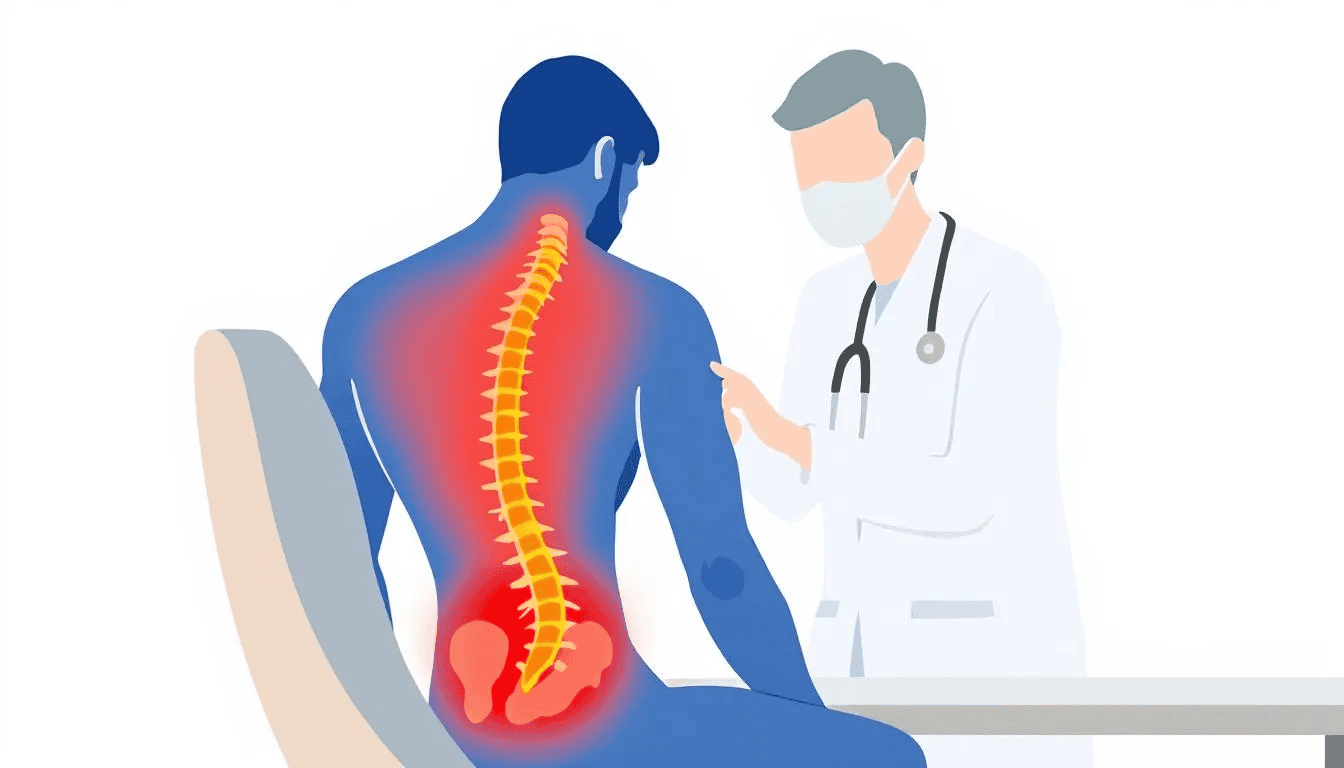
While many sciatica symptoms can be managed with conservative treatments, certain severe symptoms require immediate medical attention. These include sudden numbness or weakness in the legs, which can indicate significant nerve damage. Difficulty controlling bladder or bowel function is another red flag that should prompt urgent care.
If both sides of the body are affected or if there is severe weakness or numbness in both legs, immediate medical intervention is necessary. These severe cases can lead to significant muscle weakness, affecting leg swelling and requiring prompt evaluation and treatment.
Ignoring these symptoms can result in permanent damage, so seek help without delay.
Common Causes of Sciatica
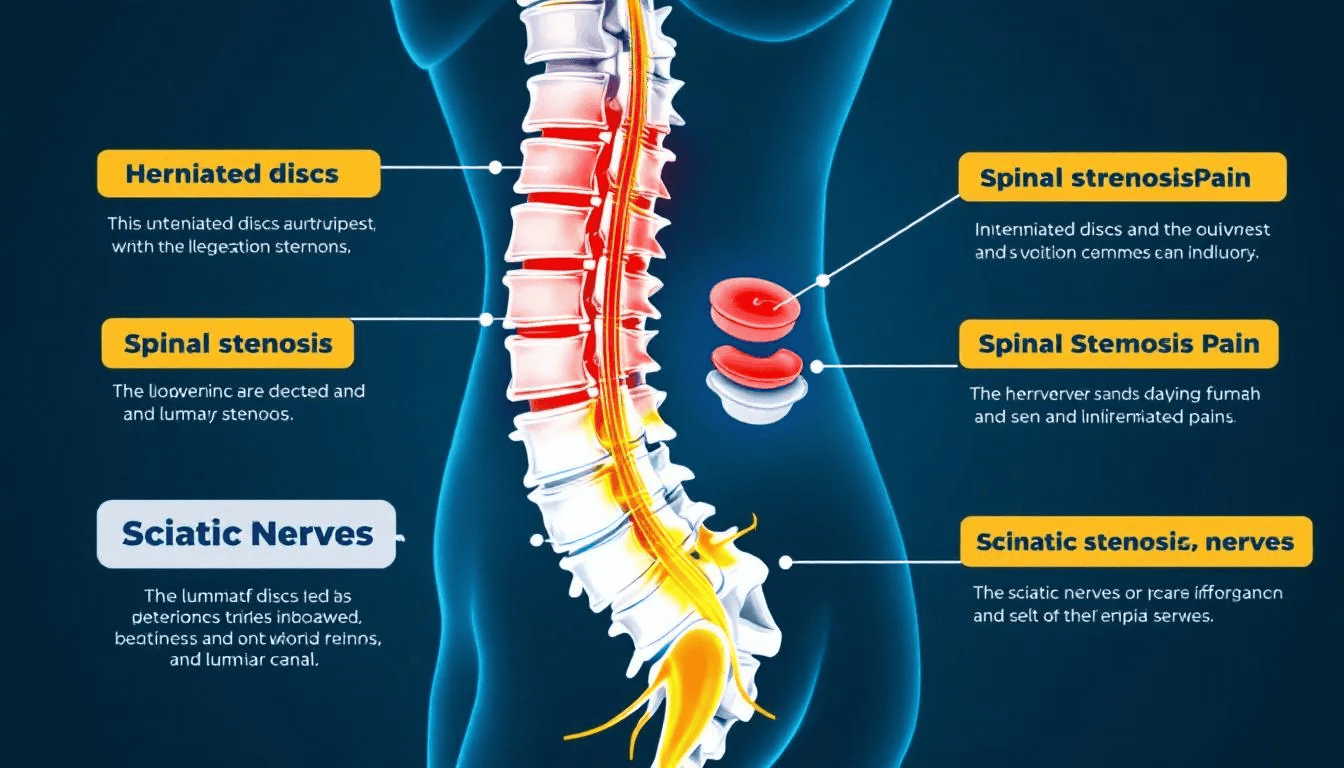
Understanding the common causes of sciatica can help in both prevention and treatment. Herniated discs and spinal stenosis are among the most frequent culprits, causing nerve compression that leads to sciatica pain. A common cause of sciatica is a lumbar herniated disc, which occurs when the soft center of a spinal disc protrudes through a tear and presses on nerve roots. These conditions create pressure on the sciatic nerve, resulting in the characteristic pain and discomfort.
Piriformis syndrome is another cause, where the piriformis muscle irritates the sciatic nerve, contributing to sciatica. Other common causes of sciatica include degenerative disc disease and spinal stenosis, which can narrow the spaces around the spinal cord. Factors like inflammation, muscle spasms, and chronic sitting can also play a role in developing sciatica. Identifying these causes can guide effective treatment and preventive measures.
Diagnosing Sciatica
Diagnosing sciatica involves a combination of:
- Medical history: helps identify risk factors and symptoms
- Clinical examinations: assess nerve function and pain response
- Imaging techniques: such as MRI scans, which are particularly effective for visualizing herniated discs that might be compressing the sciatic nerve. A physical examination will often focus on assessing the range of motion, muscle strength, and reflexes. Additionally, healthcare providers may diagnose sciatica based on these assessments.
CT scans provide detailed 360-degree images of the spine, revealing conditions that cause sciatica. X-rays can identify bone spurs or tumors affecting the sciatic nerve, while electromyography (EMG) assesses muscle response and nerve activity to pinpoint nerve damage related to sciatica. Specific tests can help identify the exact source of nerve compression during diagnosis.
These diagnostic tools are crucial for developing an effective appropriate treatment plan.
Treatment Options for Sciatica
There are various treatment options available for sciatica. These include:
- Self-care measures
- Conservative treatments such as physical therapy, medications, and lifestyle changes designed to alleviate pain and improve function
- More formal medical interventions like injections or surgical interventions in more severe cases
Understanding the full spectrum of treatment options can help patients make informed decisions about their care. Exploring these options in detail can provide better insights, starting with conservative treatments.
Conservative Treatments
Nonsurgical treatments for sciatica encompass several options. These include cold or heat therapy, medications, physical therapy, and acupuncture. Self-treatments can include rest, applying ice or heat, and stretching. Medications that can help alleviate sciatica pain include over-the-counter pain relievers, prescription muscle relaxants, anti-seizure drugs, and antidepressants. Physical therapy focuses on strengthening muscles, improving flexibility, and reducing pressure on the sciatic nerve to help manage pain. Sciatica treated with these methods can provide significant relief.
Self-care measures that can significantly aid in managing sciatica symptoms include:
- Rest
- Lower back stretches
- Ice application
- Maintaining good posture
Conservative treatments aim to provide temporary relief and improve quality of life.
Injections
Corticosteroid injections are commonly used to manage sciatica pain by reducing inflammation. The primary purpose of these injections is to provide temporary relief, allowing patients to engage in physical therapy and other treatments that can address the underlying causes of their pain.
Epidural injections may be recommended for severe pain that has not responded to other treatments. While these injections can provide significant relief, they are typically considered a short-term solution within a comprehensive treatment plan.
Surgical Interventions
Surgery may become necessary for severe cases of sciatica that do not respond to conservative methods to manage pain. Common surgical procedures for sciatica include discectomy and laminectomy, which aim to relieve pressure on the sciatic nerve. Surgery is usually not recommended unless symptoms indicate nerve damage is occurring or imminent.
Spinal decompression surgery may alleviate nerve pressure and is sometimes accompanied by lumbar fusion to enhance spine stability. The primary goal of these surgical interventions is to relieve pain, numbness, and weakness associated with lumbar radiculopathy, thereby improving the patient’s quality of life.
Managing Sciatica Pain at Home

Managing sciatica pain at home involves practical strategies and lifestyle adjustments. Using alternating hot and cold packs can be effective in managing ongoing pain. Over-the-counter pain relievers like ibuprofen or naproxen may help alleviate discomfort.
Maintaining proper posture while sitting and standing can contribute positively to managing sciatica. Gentle exercise and stretches, along with good posture habits, can prevent sciatica from worsening and promote overall spinal health.
Preventing Sciatica
Preventing sciatica involves a proactive approach to spinal health. Core muscles strength is vital for spinal stability; exercises targeting the abdominal, back, and pelvic muscles are beneficial. Engaging in a variety of exercises like aerobic, strength training, and flexibility workouts can help lower the risk of sciatica.
Maintaining a good posture can help not only in preventing new pain but also in alleviating existing discomfort. Avoiding prolonged sitting, taking frequent breaks, and using standing desks can reduce the risk of developing sciatica.
When to Seek Medical Help
Seek immediate medical attention if you experience:
- Significant leg weakness
- Loss of sensation
- Sudden bowel or bladder function
- Sudden lower back pain
- Sciatica pain that does not improve after conservative treatment
If symptoms persist beyond three days or if experiencing severe pain, genital numbness, or difficulty urinating, consult a doctor. Timely medical intervention can prevent complications and promote recovery.
Summary
Recognizing and managing sciatica starts with understanding its symptoms and underlying causes. From conservative treatments to surgical interventions, knowing your options can empower you to take control of your pain. Implementing preventive measures can reduce the risk of future flare-ups and improve overall spinal health.
Remember, seeking timely medical help for severe symptoms is crucial to prevent lasting damage. Take the first step towards a pain-free life by staying informed and proactive in managing your sciatica.
Frequently Asked Questions
What is sciatica pain?
Sciatica pain is discomfort that begins in the lower back or buttock and radiates down the leg, typically resulting from irritation or compression of the sciatic nerve.
What are common symptoms of sciatica?
Common symptoms of sciatica encompass radiating pain from the lower back down one leg, accompanied by tingling, numbness, and potential muscle weakness in the affected leg. It is essential to recognize these signs for timely intervention.
What causes sciatica?
Sciatica is primarily caused by conditions such as herniated discs, spinal stenosis, and piriformis syndrome, which compress or irritate the sciatic nerve. Identifying the underlying cause is essential for effective treatment.
How is sciatica diagnosed?
Sciatica is diagnosed through a detailed medical history, physical examination, and imaging tests like MRI, CT scans, or X-rays to determine the root cause. Accurate diagnosis is essential for effective treatment.
When should I seek medical help for sciatica?
You should seek medical help for sciatica if you experience significant leg weakness, loss of sensation, sudden bowel or bladder incontinence, or if symptoms persist beyond a few days despite conservative treatment. Prompt medical attention is crucial in these situations.




